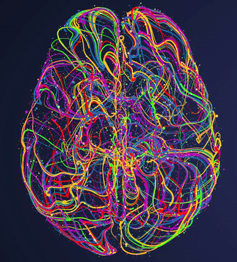
Cluster 8 had no identifying marker, but expressed many metabolic genes. Cluster 7 expressed antigen-presenting genes and stood out through its high levels of CD74, part of the major histocompatibility complex class II (MHCII). Clusters 5 and 6 sported anti-inflammatory genes, and the transmembrane protein CD83, an immunoglobulin. Cluster 4 turned on genes related to the interferon response, and could be identified by the gene ISG15, which encodes a ubiquitin-like protein induced by interferon. In cluster 3, genes involved in the cellular stress response were active, and these microglia were more abundant in AD brains than in the surgical samples. Other subtypes were more distinctive (see image at right).

These clusters expressed no unusual transcription factors or cell-surface markers. More than 80 percent of the microglia fell into clusters 1 and 2, which seemed to represent homeostatic cells. Single-cell RNA-Seq defined nine transcriptional subtypes. From these samples, the authors isolated a total of 16,096 microglia. The authors rounded out this material with surgical resections of temporal cortex from three younger, cognitively healthy people undergoing treatment for epilepsy. Researchers removed tissue samples from the skull within a few hours of death, placing them in a medium that keeps microglia alive ( Olah et al., 2018). To get living cells, joint first authors Marta Olah and Vilas Menon used fresh autopsy tissue from the dorsolateral prefrontal cortices of 14 participants in the Rush Memory and Aging Project who had had cognitive impairment or AD dementia. ĭe Jager and colleagues wanted to examine many more than that. Ns reflect number of microglia in each cluster. Circle size indicates the relative percentage of microglia in the cluster that express a given gene, with the largest circle being 100 percent. High (red) or low (blue) expression of specific genes characterizes nine microglial subtypes. Just one previous study has done this, when researchers led by Marco Prinz at the University of Freiburg in Germany analyzed 4,400 freshly isolated human microglia by single-cell RNA-Seq ( Nov 2019 news).Įxpression Profiles. Whole microglia can only be isolated from living tissue. In addition, analyzing nuclei rather than whole cells may miss some cytoplasmic transcripts responsible for microglial activation ( Oct 2020 news). Louis turned to single-nuclei RNA-Seq of postmortem brain samples to zero in on activation states alas, the number of microglia isolated from these mixed cortical cell samples was low, around 2,000 to 3,000 ( May 2019 news Jan 2020 news). Recently, groups led by Li-Huei Tsai at the Massachusetts Institute of Technology and Marco Colonna at Washington University in St. Most previous studies of gene expression in human microglia relied on bulk tissue samples, and were unable to pick out subtypes ( Jun 2017 news Jul 2017 news Feb 2018 news). “This dataset will be very valuable to future understanding of the role of microglia in Alzheimer's disease,” he wrote (full comment below). Mark Fiers at KU Leuven, Belgium, agreed. Every human microglial project is a gold mine,” Oleg Butovsky at Brigham and Women’s Hospital, Boston, told Alzforum. scRNA-Seq of human microglia finds that most belong to one of two homeostatic subtypes (MG1 and MG2), and seven other activation states are present in all brain samples examined. Some of the data were presented at a 2018 Keystone Symposium ( Jul 2018 conference news). They offer a more refined view of different transcriptional states, and they reinforce differences in how humans and mice respond to amyloidosis. Overall, the findings are broadly similar to previous microglial data from both mice and people. This implies therapeutic approaches will need to be precisely targeted to affect only the relevant subtype, he added. “The microglia involved in disease are probably in these minor subsets,” De Jager told Alzforum.



 0 kommentar(er)
0 kommentar(er)
